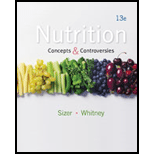
Nutrition: Concepts and Controversies
13th Edition
ISBN: 9781133603184
Author: Frances Sizer, Ellie Whitney
Publisher: Cengage Learning
expand_more
expand_more
format_list_bulleted
Question
Chapter 14, Problem 2RQ
Summary Introduction
Interpretation:
Taking multivitamins, magnesium, manganese, diuretics can often cure PMS. Is it true or false?
Concept Introduction:
PMS or the premenstrual syndrome are the symptoms which the females face before two weeks of their period. This includes bloating, mood swings, feeling depressed and sad, feeling irritated, etc. it is not necessary that all the girls experience the same symptoms.
Expert Solution & Answer
Trending nowThis is a popular solution!

Chapter 14 Solutions
Nutrition: Concepts and Controversies
Ch. 14 - Prob. 1RQCh. 14 - Prob. 2RQCh. 14 - Prob. 3RQCh. 14 - Prob. 1SCCh. 14 - Prob. 2SCCh. 14 - Prob. 3SCCh. 14 - Prob. 4SCCh. 14 - Prob. 5SCCh. 14 - Prob. 6SCCh. 14 - Prob. 7SC
Ch. 14 - Prob. 8SCCh. 14 - Prob. 9SCCh. 14 - Prob. 10SCCh. 14 - Prob. 11SCCh. 14 - In research, which of the following is associated...Ch. 14 - Prob. 13SCCh. 14 - Prob. 14SCCh. 14 - Prob. 15SCCh. 14 - Prob. 16SCCh. 14 - The word DETERMINE is an acronym used in assessing...Ch. 14 - Prob. 18SCCh. 14 - Prob. 19SC
Knowledge Booster
Recommended textbooks for you
 Nutrition: Concepts and Controversies - Standalo...Health & NutritionISBN:9781305627994Author:Frances Sizer, Ellie WhitneyPublisher:Brooks ColeEssentials of Pharmacology for Health ProfessionsNursingISBN:9781305441620Author:WOODROWPublisher:Cengage
Nutrition: Concepts and Controversies - Standalo...Health & NutritionISBN:9781305627994Author:Frances Sizer, Ellie WhitneyPublisher:Brooks ColeEssentials of Pharmacology for Health ProfessionsNursingISBN:9781305441620Author:WOODROWPublisher:Cengage Biology: The Unity and Diversity of Life (MindTap...BiologyISBN:9781305073951Author:Cecie Starr, Ralph Taggart, Christine Evers, Lisa StarrPublisher:Cengage Learning
Biology: The Unity and Diversity of Life (MindTap...BiologyISBN:9781305073951Author:Cecie Starr, Ralph Taggart, Christine Evers, Lisa StarrPublisher:Cengage Learning

Nutrition: Concepts and Controversies - Standalo...
Health & Nutrition
ISBN:9781305627994
Author:Frances Sizer, Ellie Whitney
Publisher:Brooks Cole


Essentials of Pharmacology for Health Professions
Nursing
ISBN:9781305441620
Author:WOODROW
Publisher:Cengage

Biology: The Unity and Diversity of Life (MindTap...
Biology
ISBN:9781305073951
Author:Cecie Starr, Ralph Taggart, Christine Evers, Lisa Starr
Publisher:Cengage Learning

